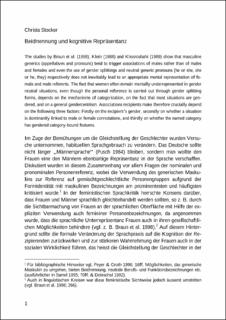Please use this identifier to cite or link to this item:
https://doi.org/10.21256/zhaw-1446Full metadata record
| DC Field | Value | Language |
|---|---|---|
| dc.contributor.author | Stocker, Christa | - |
| dc.date.accessioned | 2018-09-18T11:59:50Z | - |
| dc.date.available | 2018-09-18T11:59:50Z | - |
| dc.date.issued | 2000 | - |
| dc.identifier.issn | 1023-2044 | de_CH |
| dc.identifier.uri | https://digitalcollection.zhaw.ch/handle/11475/10722 | - |
| dc.description.abstract | The studies by Braun et al. (1998), Klein (1988) and Khosroshahi (1989) show that masculine generics (appellatives and pronouns) tend to trigger associations of males rather than of males and females and even the use of gender splittings and neutral generic pronouns (he or she, she or he, they) respectively does not inevitably lead to an appropriate mental representation of female and male referents. The fact that women often remain mentally underrepresented in gender neutral situations, even though the personal reference is carried out through gender splitting forms, depends on the mechanisms of categorization, on the fact that most situations are gendered, and on a general gendercentrism. Associations recipients make therefore crucially depend on the following three factors: Firstly on the recipient’s gender, secondly on whether a situation is dominantly linked to male or female connotations, and thirdly on whether the named category has gendered category-bound features. | de_CH |
| dc.language.iso | de | de_CH |
| dc.publisher | Vereinigung für Angewandte Linguistik in der Schweiz | de_CH |
| dc.relation.ispartof | Bulletin suisse de linguistique appliquée | de_CH |
| dc.rights | Licence according to publishing contract | de_CH |
| dc.subject | Stereotyp | de_CH |
| dc.subject | Linguistik | de_CH |
| dc.subject | Repräsentation | de_CH |
| dc.subject | Sprache | de_CH |
| dc.subject | Kategorisierung | de_CH |
| dc.subject | Vorurteil | de_CH |
| dc.subject.ddc | 401.4: Terminologie, Diskursanalyse, Pragmatik | de_CH |
| dc.title | Beidnennung und kognitive Repräsentanz | de_CH |
| dc.type | Beitrag in wissenschaftlicher Zeitschrift | de_CH |
| dcterms.type | Text | de_CH |
| zhaw.departement | Angewandte Linguistik | de_CH |
| zhaw.organisationalunit | Institut für Übersetzen und Dolmetschen (IUED) | de_CH |
| dc.identifier.doi | 10.21256/zhaw-1446 | - |
| zhaw.funding.eu | No | de_CH |
| zhaw.issue | 72 | de_CH |
| zhaw.originated.zhaw | No | de_CH |
| zhaw.pages.end | 153 | de_CH |
| zhaw.pages.start | 139 | de_CH |
| zhaw.publication.status | publishedVersion | de_CH |
| zhaw.volume | 2000 | de_CH |
| zhaw.publication.review | Peer review (Publikation) | de_CH |
| Appears in collections: | Publikationen Angewandte Linguistik | |
Files in This Item:
| File | Description | Size | Format | |
|---|---|---|---|---|
| 2000_Stocker_Beidnennung_und_kognitive_Repräsentanz_VALS_ASLA.pdf | 62.19 kB | Adobe PDF |  View/Open |
Show simple item record
Stocker, C. (2000). Beidnennung und kognitive Repräsentanz. Bulletin suisse de linguistique appliquée, 2000(72), 139–153. https://doi.org/10.21256/zhaw-1446
Stocker, C. (2000) ‘Beidnennung und kognitive Repräsentanz’, Bulletin suisse de linguistique appliquée, 2000(72), pp. 139–153. Available at: https://doi.org/10.21256/zhaw-1446.
C. Stocker, “Beidnennung und kognitive Repräsentanz,” Bulletin suisse de linguistique appliquée, vol. 2000, no. 72, pp. 139–153, 2000, doi: 10.21256/zhaw-1446.
STOCKER, Christa, 2000. Beidnennung und kognitive Repräsentanz. Bulletin suisse de linguistique appliquée. 2000. Bd. 2000, Nr. 72, S. 139–153. DOI 10.21256/zhaw-1446
Stocker, Christa. 2000. “Beidnennung und kognitive Repräsentanz.” Bulletin suisse de linguistique appliquée 2000 (72): 139–53. https://doi.org/10.21256/zhaw-1446.
Stocker, Christa. “Beidnennung und kognitive Repräsentanz.” Bulletin suisse de linguistique appliquée, vol. 2000, no. 72, 2000, pp. 139–53, https://doi.org/10.21256/zhaw-1446.
Items in DSpace are protected by copyright, with all rights reserved, unless otherwise indicated.